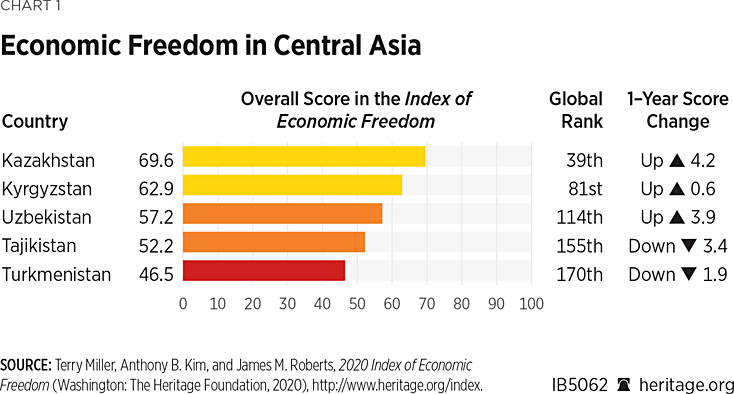The Trump Administration’s recently unveiled Central Asia strategy states that:
The United States’ primary strategic interest in this region is to build a more stable and prosperous Central Asia that is free to pursue political, economic, and security interests with a variety of partners on its own terms; is connected to global markets and open to international investment; and has strong, democratic institutions, rule of law, and respect for human rights.REF
To pursue the vision of “advancing sovereignty and economic prosperity”REF in Central Asia effectively, the Trump Administration and Congress should make enhancing economic freedom in the region the focal point of America’s strategic engagement efforts.
A Critical Region Calling for America’s Renewed Attention
Central Asia is a critical, if often overlooked, region for the United States. It consists of the former Soviet republics of Kazakhstan, Kyrgyzstan, Tajikistan, Turkmenistan, and Uzbekistan. These five landlocked countries of the Central Asian region, which “has always been the strategic and commercial crossroad of civilizations between Europe and Asia,”REF are diverse in their history, culture, religion, and levels of development, and their natural resource endowments make the region even more strategically important for the United States.
In fact, many of the challenges that the U.S. now faces around the world, such as a resurgent Russia, an emboldened Iran, and the rise of Islamist extremism, have converged in Central Asia. Not surprisingly, a resurgent China has attempted to make greater inroads in the region as part of its Belt and Road Initiative.
While recognizing this evolving geopolitical circumstance, the Administration’s Central Asia strategy points out that new leaders and governments in the region have created fresh openings for reform-oriented development and greater U.S. engagement, notably indicating “a deeper commitment to pursue political and economic reform, including through bilateral cooperation with the United States.”REF One of the critical policy objectives that the strategy identifies is to “promote United States investment in and development of Central Asia.”REF
Needless to say, the U.S. cannot give countries in the Central Asian region the political will that they need to transform their economies according to free-market principles. However, becoming involved at critical policy dialogue and implementation levels, the U.S. can ensure that its guidance and concerns are taken into account. The U.S. can also engage at the technical level in a way that enables countries to advance their economic development. Fundamentally, America’s economic strength and competitive advantage in the region will be exercised best through the private-sector engagement that is the catalyst for real, meaningful economic transformation.
The Current State of Economic Freedom in Central Asia
The volume of American trade with all five Central Asian countries has been relatively insignificant. In an effort to “address trade issues and help enhance U.S.–Central Asian trade,” the United States and the five countries in the region signed a Trade and Investments Framework Agreement in 2004.REF The business environment of the region as a whole, nonetheless, remains hampered by the severe economic freedom deficit caused by the weak rule of law, poor regulatory efficiency, and the lack of market openness, all of which has made the region unattractive to American investors. Overall trade turnover between the U.S. and Central Asia has been growing only slowly.
More fundamentally, Central Asia’s transition to a private sector–driven market economy has been gradual and not deep enough. According to The Heritage Foundation’s annual Index of Economic Freedom, which assesses the entrepreneurial policy frameworks of 186 countries around the globe,REF apart from Kazakhstan (ranked 39th) and Kyrgyzstan (81st), whose economies are rated “moderately free,” countries in the region have been mired in the ranks of the “mostly unfree” (Uzbekistan, 114th, and Tajikistan, 155th) or “repressed” (Turkmenistan, 170th).

Although it is notable that Kazakhstan and Uzbekistan are two of the 10 most improved nations in the 2020 Index, the region’s overall progress toward greater economic freedom has been uneven. The presence of state-owned enterprises in Central Asia as a whole remains considerable, with the private sector intertwined with the public sector and the risks of expropriation lingering.
Central to the task of advancing economic freedom and an enabling business environment in the region must be committed economic statecraft that creates a more inviting playing field for American companies and private investors, as well as ensuring U.S. leadership in market opening and high-standard rulemaking.
It is in that direction that the most promising future for the countries of Central Asia can be found. Several are well along the way. It is now time for the others to act on the necessity of pursuing and implementing critical reforms.
More proactively adopting policies that enhance economic freedom will aid development on both the economic and political fronts. Greater growth and broad-based development contributes both to political stability and, by empowering more people to participate actively in the life of their communities, to pluralism and democracy.
A Road Map for Progress
In crafting a coherent and comprehensive road map that will advance America’s strategic interest of “enhance[ing] economic prosperity” and “promot[ing] private-sector engagement” in Central Asia, the Trump Administration and Congress should:
- Create a bold, consistent narrative about the benefits of market liberalization and openness. This narrative should highlight the positive consequences of economic freedom, including its positive impact on individual states, the value of imports to the national economy, the realities of the global value chains and their value to the U.S., and the constructive effects of economic growth on overall development. The U.S. should highlight the attractiveness of the governance and economic model that it exemplifies.
- Encourage pro-market, pro-investment policies in the region. Many countries in the region need to be encouraged to adopt policies that will lure private investment and facilitate market-led economic growth and development. Greater economic freedom means freeing untapped entrepreneurs and unleashing Central Asian countries’ economic potentials, which are necessary for sustained growth and development. Central Asia cannot afford not to do this. It should be encouraged to adopt free-market policies that facilitate development that is led by the private sector, because the real long-term transformative investments in the region will come ultimately from the private sector.
- Exercise strategic flexibility and incentivize reforms. The U.S. should insist on free trade, open investment environments, transparent agreements between nations, and improved connectivity to drive regional ties. That is in the interest of the U.S. and of the countries in Central Asia. But the U.S. can be flexible in other, constructive ways—not necessarily in the context of formal agreements. The U.S. and countries in the region have a mutual interest, for instance, in helping small and medium-size businesses grow and compete regionally as well as globally.
- Work closely with the World Bank and the Asian Development Bank. These development institutions, in which the U.S. has played a leading role as a member and donor, can and should exercise a more practical influence on improving the entrepreneurial framework in its member nations in Central Asia. Exercising strong leadership in holding the development institutions whose engagement with America has been multifaceted accountable for their practices is clearly in America’s interest. Effective development assistance should focus on advancing private-sector growth that aims to eliminate policy obstacles to the facilitation of dynamic entrepreneurship.
Conclusion
The U.S. should take a multifaceted approach to advancing its interests, building relationships, and confronting adversarial efforts in the Central Asian region. The region is a crucial geostrategic and commercial crossroads linking Europe and Asia. In “deepening engagement with the United States,” as the Trump Administration’s Central Asia strategy makes clear, “each country should implement reforms that open the region to international investment and strengthen democratic institutions.”REF To that end, effectively encouraging the countries of Central Asia to adopt greater economic freedom depends in no small part on America’s coherent strategy for ensuring sovereignty and economic prosperity in the region.
Anthony B. Kim is Research Manager and Editor of the Index of Economic Freedom in the Center for International Trade and Economics, of the Kathryn and Shelby Cullom Davis Institute for National Security and Foreign Policy, at The Heritage Foundation.



